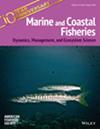Evaluating the impact of tuna purse-seine fishing under fish aggregating devices and free schools on Little Tunny in the Northeast Atlantic Ocean: Implications using length-based methods
Abstract
Objective
Little Tunny Euthynnus alletteratus is a commercially viable species, and its research has been prioritized by the International Commission for the Conservation of Atlantic Tunas. This study aimed to evaluate the stock status of Little Tunny in the Northeast Atlantic Ocean, the effectiveness of the life history priors, and the sensitivity of the model's predicted reference points to prior misspecification. The findings could help reduce uncertainties regarding the state of Little Tunny in the region.
Methods
We used empirically estimated life history parameters and purse-seine fish aggregating device (FAD) and free school fishing length-frequency data from 2000 to 2021, available in the International Commission for the Conservation of Atlantic Tunas database. We applied the length-based Bayesian biomass (LBB) and length-based spawning potential ratio assessment methods.
Result
The LBB's outputs indicate that Little Tunny was grossly overfished at the exerted fishing pressure. This was corroborated by length-based spawning potential ratio estimates of low spawning per recruit for the stock exploited by purse seines under FAD and free school sets. The reference points of both models were most sensitive to asymptotic length (L∞) prior misspecification, and including life history priors in LBB produced a narrower confidence interval of the estimated reference points.
Conclusion
The Northeast Atlantic Ocean Little Tunny fishery exploited by purse-seine fisheries under FAD and free school sets may be unsustainable. We maintain that user priors could reduce uncertainty in LBB, whereas accurate specification of priors, particularly L∞, is required to have less biased results using the models. We recommend catch limits through, for instance, spatial closures, but caution is advised due to uncertainty in this study's life history priors.


 求助内容:
求助内容: 应助结果提醒方式:
应助结果提醒方式:


